"Verdun of World War II ..."
It was possible to limit the blockade following the example of Leningrad. However, for Adolf Hitler (and then for the whole world) the capture of the city had a symbolic, political significance. Therefore, they began to storm the city, disregarding the losses, and eventually got bogged down, lost time and initiative, not counting the enormous amount of manpower and equipment that they put in city battles, and to hold the territory.
The second stage of the defensive operation of the Soviet troops to hold Stalingrad began on September 13 and lasted until November 18 1942, on the eve of the Soviet transition to a decisive counterattack. At this stage of the operation, the enemy stormed the city four times. Fights within the city were distinguished by exceptional stubbornness, perseverance and massive heroism of the defenders of Stalingrad.
The persistence and perseverance of the Soviet troops struck even German generals. A participant in the battle of Stalingrad, German General G. Derr later wrote: “For every house, workshop, water tower, embankment, wall, basement, and finally, for every pile of garbage, a fierce struggle was waged that was unparalleled even during the First World War war with her gigantic ammunition consumption. The distance between our troops and the enemy was extremely small. Despite massive action aviation and artillery, it was impossible to leave the melee area. The Russians were superior to the Germans in terms of terrain and camouflage and were more experienced in barricade battles behind individual houses: they took up a solid defense.
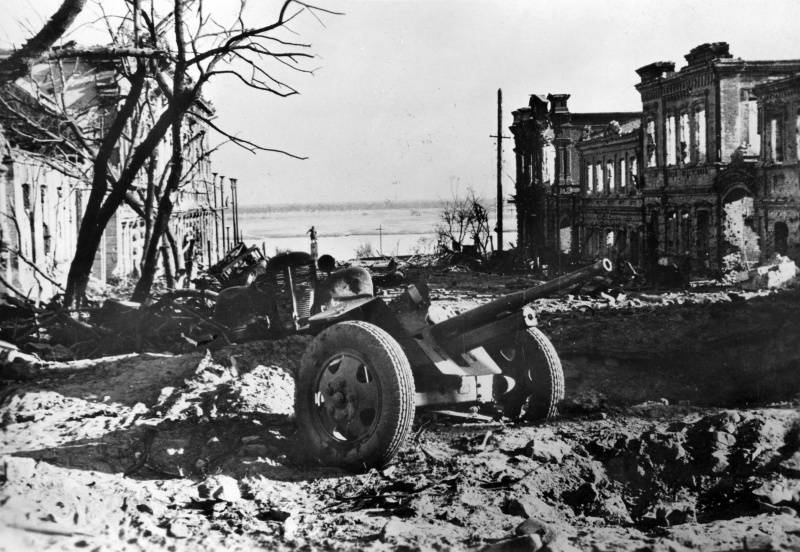
Broken Soviet 45-mm anti-tank gun on Lenin Street in Stalingrad
Plans of the parties. Location of troops
The situation in the region of Stalingrad was critical. In early September 1942, the 62nd Army retreated to the western and northern outskirts of the city, and the 64th Army to the southern. The troops of these armies suffered heavy losses in manpower and equipment. However, there was no choice, so the command assigned the direct defense of Stalingrad to the 62nd and 64th armies. They had to take the brunt of the enemy. The rest of the troops of the Stalingrad direction, by their actions, delayed part of the enemy’s forces from the directions of its main attacks. By September 13, the troops of the Stalingrad Front were defending at the line of Pavlovsk, Panshino, Samofalovka, Erzovka, and the troops of the Southeast Front - at the line of Stalingrad - Elista. These fronts contained a significant number of formations, but many of them were poorly equipped. Ground forces supported the 16th and 8th Air Armies, as well as the Volga Military flotilla.
The German command continued to build up forces in the Stalingrad direction. Army Group B had 42 divisions in July, 69 by the end of August, and 81 divisions by the end of September. This strengthening was carried out primarily due to the transfer of troops from Army Group “A”, from its reserve and from the Caucasian direction, which ultimately negatively affected the Wehrmacht’s offensive in the Caucasus (the Germans lost the battle for the Caucasus). The German command transferred the 9th and 11th infantry divisions here from Romania, the infantry brigade from Italy, and the 5th and 2nd Romanian army corps from the Army Group “A”. The troops of their allies - Romanians and Italians - the Germans put on passive sections of the front. They were weaker - in terms of combat training, spirit and material and technical part - than German divisions. As a result, on September 13, the 8th Italian, 6th and 4th were operating against the Stalingrad and Southeast fronts tank German armies, and a total of 47 divisions (including 5 tank and 4 motorized).
With the withdrawal of troops 6 th field and 4 th tank armies to the outskirts of Stalingrad, the German command decided to launch an assault on the city. On September 12, the commander of Army Group B, Weichs, and the commander of the 6 Army arrived at Hitler’s headquarters near Vinnitsa. At the meeting, the Führer demanded the speedy capture of Stalingrad: “The Russians are on the verge of exhaustion of their forces. Resistance at Stalingrad should be assessed only as local. They are no longer capable of strategic actions that could be dangerous for us. In addition, the northern flank of the Don will receive significant reinforcement from the Allies. Under these circumstances, I do not see a serious danger to the northern flank. Otherwise, we must take care to quickly take the city into our own hands, and not allow it to turn into a devouring focus for a long time. ” As a result, it happened - Stalingrad turned into “an all-devouring focus for a long time.”
The commander of the 6 Army Paulus asked for an additional three divisions and promised to take Stalingrad in 10 days. The German command believed that the capture of the city would take a little time. By the end of September 12, German troops were almost at the walls of the Stalingrad Tractor Plant and in 3-4 km from the city center. The forces of Paulus 6 in this lane numbered about 100 thousand soldiers and officers, about 2000 guns and mortars, 500 tanks and assault guns. The Germans had complete air supremacy. It is worth noting that the German troops were already exhausted by the battles, there were only 60 people left in the companies, and the tank divisions had operational tanks on the 60-80. Paulus decided to launch an assault on Stalingrad from the capture of its northern and central regions. To do this, it was planned to simultaneously deliver a powerful blow 2 and break through to the Volga. For this purpose, two groups were concentrated: one in the 295, 71, 94 and infantry and 24 tank divisions - in the area of Aleksandrovka village, the other from the 14 tank, 29- and 20- th Romanian infantry divisions - in the area of Upper Elshanka. The task seemed simple: to go through the 5-10 km battle and throw the Russians into the river.
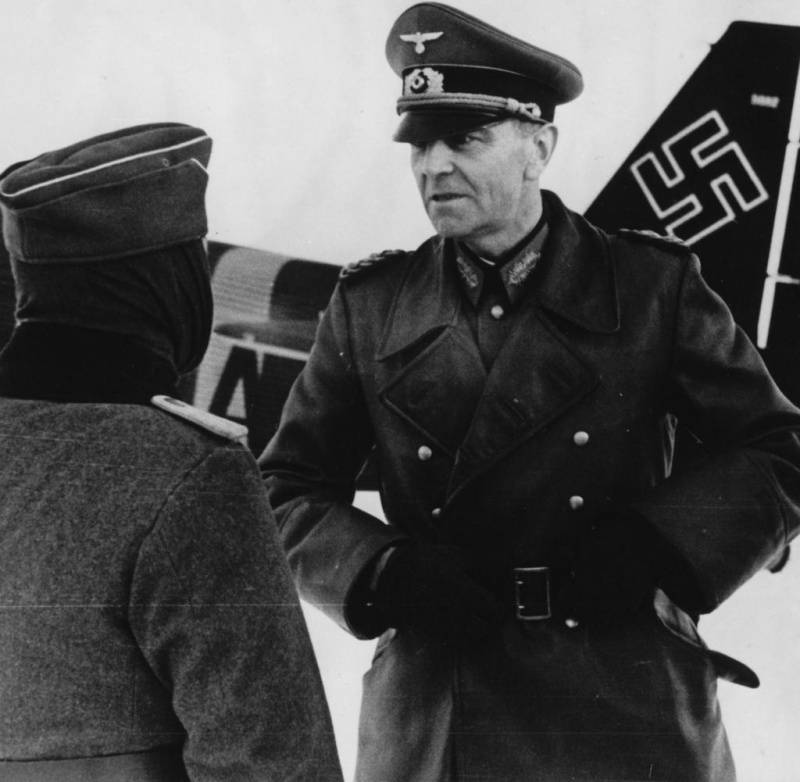
Colonel-General F. Paulus talks to a subordinate at Stalingrad
The city was defended by the 62 and 64 armies. The front line in front of the 62 and 64 armies was continuous and ran up to 65 km along the right bank of the Volga from the Rynok settlement, Orlovka in the north and further along the western outskirts of the city to its southern tip in the Kirovsky district to the Small Chapurniki. The 64 Army defended at the Kuporenoye-Ivanovka line, about 25 km long. Army troops had a one-echelon operational formation. Its main forces were concentrated on the right flank, covering the most dangerous direction.
The front of the 62 Army is about 40 km long and passes from the right bank of the Volga near the village of Rynok, through Orlovka, east of the Settlement and Razgulyaevka, Sadovaya, Kuporosnaya. The maximum distance from the Volga coast near Orlovka was 10 km. The whole burden of the task of protecting the central part of Stalingrad and the factory districts fell on the army. On September 5, General Lopatin was removed from his post, proposing to withdraw the troops beyond the Volga. The new commander of the 62 Army was appointed General V. I. Chuikov. In the army there were 12 rifle divisions (33-I and 35-I Guards, 87-I, 98-I, 112-I, 131-I, 196-I, 229-I, 244-I, 315-I, 399-I me and 10-Rifle Division NKVD), 7 rifle (10-I, 38-I, 42-I, 115-I, 124-I, 129-I, 145-I) and 5 tank brigades, 20-I fighter brigade, 12 artillery and mortar regiments. However, the divisions were drained of blood, consisted of 250-100 fighters. That is, some divisions had fewer soldiers than a full-fledged battalion. In addition, some divisions were armed with only a few guns. The tank brigades were on 6-10 tanks. The total number of 35 Guards along with the attached units was 664 man, 23 tank corps had 40-50 tanks, of which a third were used as fixed firing points. 10-division of the NKVD (7500 people), and 3 separate infantry brigades were more or less manned. Total 62-I army had about 54 thousand people by the middle of September, 900 guns and mortars, 110 tanks. There was no elbow connection with the neighbors; the flanks of the army rested against the Volga. There were no reserves.
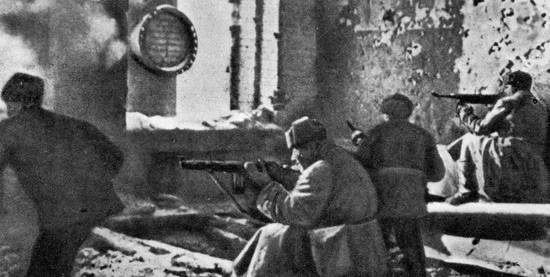
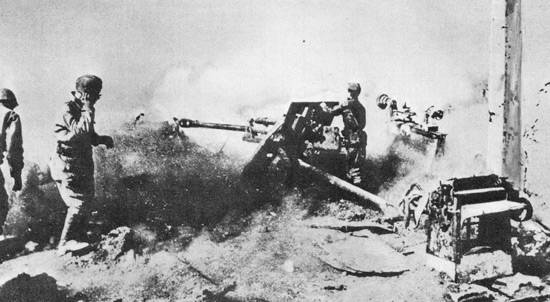
Defensive battles in Stalingrad
Assault
September 13 German troops launched an assault on Stalingrad. They delivered the main blow in the direction of Mamayev Kurgan and the railway station. On the first day they managed to press a few Soviet units. In the evening, the front commander ordered Chuikov to dislodge the enemy from occupied areas and restore the situation. September 14 in the early morning part of the 62 Army passed to the counterattack, which had no success. By 12 hours, the Germans concentrated 5 divisions and more than 1 thousand guns on a narrow section of the front and struck a powerful blow. From the air they were supported by hundreds of aircraft. The fighting went on the streets of the city. This day was one of the most difficult for the defenders of Stalingrad.
Chuikov described this moment in the following way: “Despite the enormous losses, the invaders climbed ahead. Columns of infantry in tanks and cars broke into the city. Apparently, the Nazis believed that his fate was solved, and each of them sought to reach the Volga, the center of the city as soon as possible, and benefit from trophies there. Our fighters ... saw drunken Hitlerites jumping from cars, playing harmonica and dancing on sidewalks. The fascists died by the hundreds, but the fresh waves of reserves increasingly flooded the streets. ”
Our troops, defending themselves in Stalingrad, had strong support from the artillery. On the left bank of the Volga, the defenders supported 250 guns and heavy mortars of the front artillery group - 6 artillery and mortar regiments, 2 artillery of the Tank Corps, anti-aircraft artillery of the Stalingrad air defense corps, 4 rocket artillery regiment. The ships of the Volga Military Flotilla fired at the enemy troops from their fifty guns breaking into the city.
However, despite the losses and heavy fire of the Soviet artillery, in the evening the Nazis seized the station and Mamayev Kurgan, which dominated the whole city and the left bank of the Volga. The battle was just a few hundred meters from the command post of the 62 Army, located in the beam of the Tsaritsa River at its mouth. There was a threat of breakthrough of the enemy to the central crossing. There were almost no troops in the center of Chuikov - in the vicinity of the station, the defense force was holding a detachment of the 62 Army. To defend the crossing, Chuikov ordered that several tanks from the heavy tank brigade, his last reserve, be thrown at the reinforcement of the soldiers who defended it. General NI Krylov (former chief of the operational department of the headquarters of the Maritime Army and the head of this headquarters, became famous during the heroic defense of Odessa and Sevastopol) formed two groups of officers of the army headquarters and soldiers of the guard company. The Germans, having broken through to the pier, were pushed aside from the crossing to the station Stalingrad-1. Persistent battles were fought on the left flank, in the area of the Minin suburb, where the divisions of the Goth army were torn forward. The city was on the verge of a fall.
On the same day, the enemy broke through the defenses at the junction of the 62 and 64 armies: the 5-kilometer section of the Upper Elshanka front was the Gornaya Polyana state farm. General IK Morozov, the former commander of the 422 Infantry Division, noted in his memoirs: “Rejecting the left flank of the 62 Army — the Guards Division of General Glazkov — and the right flank of the 64 Army — the Colonel Denisenko’s Guards Division, the master of the Captain , repair plant and went to the Volga, continuing to push the parts of the 64 Army to the south, to the Old Otrada and Beketovka, and the left flank of the 62 Army to the Elshanka and the Zatsaritsyn part of the city. ” The breakthrough of the Nazis to the Volga in the area of Kuporovoe isolated the 62 Army from the rest of the front. Our troops counterattacked, trying to restore the situation, but without much success.
The position in the center of a few straightened 15-I Guards Rifle Division, redeployed from the left bank on the night of September 13, under the command of Major General A.I. Rodimtsev (10 thousand soldiers). She immediately rushed to the Germans and knocked the enemy out of the city center. By noon, 16, September, the Germans were also thrown off Mamayev Kurgan with a blow from the 39 Guards Regiment. The attack, as described by the commander of the 1 th battalion I.I. Isakova was practically the time of Suvorov and Kutuzov: “Let's go in chains. Our attack from the outside seemed unreal. She was not preceded by any artillery preparation, or air strike. We did not support us and tanks. Nobody ran across, did not go to bed - the fighters went and went ... The enemy opened rifle-and-machine-gun fire. It was evident that people were falling in chains. Some rose and moved forward again ... The mound passed into our hands ... However, in a relatively short time of attack - and it lasted for an hour and a half two - we suffered very significant losses. Killed and wounded could be significantly less if we were supported by artillery. " Until the evening, the guards beat off a 12 counterattack. The Germans also suffered heavy losses.
The first days of the battle for the city were especially difficult for the army of Chuikov, not only because of the superiority of the forces of the enemy, but also problems with the organization and supply of troops. One day before the enemy assault, Vasiliy Chuikov was thrown onto the right bank to take a broken, bloodless army in unfamiliar terrain without normal supplies. It remained to fight to the last man, he won precious time, and “time is blood,” as Vasiliy Ivanovich himself put it later. Chuikov himself during the battles for Stalingrad so estimated the situation in the city when he arrived there. “The connection worked, and the telephone and radio. But wherever you look, everywhere a gap, everywhere a breakthrough. The divisions were so exhausted and drained of blood in previous battles that it was impossible to rely on them. I knew that I would be thrown something through 3-4 of the day, and these days were sitting on coals, when I had to scratch out some fighters, knock off something similar to a regiment and plug them into small holes. ”
At the same time, the city itself was not a fortified area, it was not prepared for long-term defense. The firing points were created hastily, and the main fortifications of the soldiers were the ruins of Stalingrad. The Military Council of the 62 Army, having heard the report of Major General Knyazev on the state of the defense of Stalingrad on September 10, noted: ““ The work on bringing the city to the defensive state was carried out at 13% ”. Anti-tank defense system is not prepared. Warehouses for ammunition, medicines, food, have not been prepared in advance. For example, Rodimtsev’s division, having lost a third of its composition, was left almost without ammunition within a day. All supplies had to be delivered back through the only working ferry and only at night. Even the wounded at first there was no one to worry. The lightly wounded soldiers made rafts themselves, loaded the seriously wounded onto them and independently swam across the Volga.
At the crossing itself, as elsewhere in Stalingrad, there was hell. On the sandbanks there were scattered machines, equipment from factories, which were dismantled, but did not have time to be taken out. On the shore stood a half-submerged, broken barges. German aviation circled over the Volga from morning till dark, and artillery beat at night. Berths and approaches to them day and night were under the fire of German guns and 6-barreled mortars. The supply of Soviet troops, supplies and materials for the 62 army was complicated to an extreme degree. To minimize losses, the ferry operated at night. During the day the wounded flocked to the shore, waited for the crossing, there was almost no medical assistance. Many were dying.
“Combat losses, waste, lack of ammunition and food, difficulties with the replenishment of people and equipment - all of this adversely affected the morale of the troops. Some had a desire to leave quickly behind the Volga, to escape from the hell, ”recalls Chuikov. Therefore, it was necessary to carry out the “black” service - the NKVD detachments inspected all the floating craft and patrolled the city, detaining suspects. So, from 13 to 15 September, 1218 soldiers were detained by a detachment of a special department of the army. There were cases of transition to the enemy. In September, 62 servicemen were shot by special divisions in the 195 Army in September.
The bitterness of both sides grew steadily, the battle assumed an almost unprecedented apocalyptic character. Not surprisingly, the survivors unanimously called it "the Stalingrad hell." On the southern outskirts of Stalingrad, from 17 to 20, September, there were battles for the highest building in this part of the city, the elevator, which was defended by the battalion of guardsmen of the 35 division. Not only the elevator as a whole, but also its individual floors and vaults passed from hand to hand several times. Colonel Dubyansky reported over the phone to General Chuikov: “The situation has changed. We used to be at the top of the elevator, and the Germans at the bottom. Now we have knocked out the Germans from below, but they have penetrated upstairs, and there, in the upper part of the elevator, there is a battle. ”
There were dozens and even hundreds of such places in the city where the Russians and Germans fought fiercely and stubbornly, arguing that they are the best warriors on the planet. Within weeks, with varying success, there was a struggle not only for each floor and basement, but also for each room, for each ledge, for each flight of the staircase. Before September 27, a fierce battle was taking place at the station. Thirteen times he passed from hand to hand, each of his assault cost both sides of hundreds of lives. The Germans, who had suffered more losses in the first yet open, dashing attacks, began to change tactics. We moved to the action assault groups. Attacks were now conducted in small areas, within one or two blocks, by a regiment or battalion with the support of 3-5 tanks. Streets and squares also became the scene of bloody battles that no longer subsided until the end of the battle.
“It was truly a titanic struggle of man against man,” General von Butlar noted, “in which the German grenadiers and sappers, who had all the modern means of combat, were slowly making their way through the city to street fighting. Such large plants as the plant to them. Dzerzhinsky, the Red Barricades and the Red October, had to be stormed separately and for several days. The city turned into a sea of fire, smoke, dust and debris. He absorbed the streams of German and Russian blood, gradually turning into Verdun of World War II ... the Russians fought with fanatical stubbornness ... The losses on both sides were enormous. "
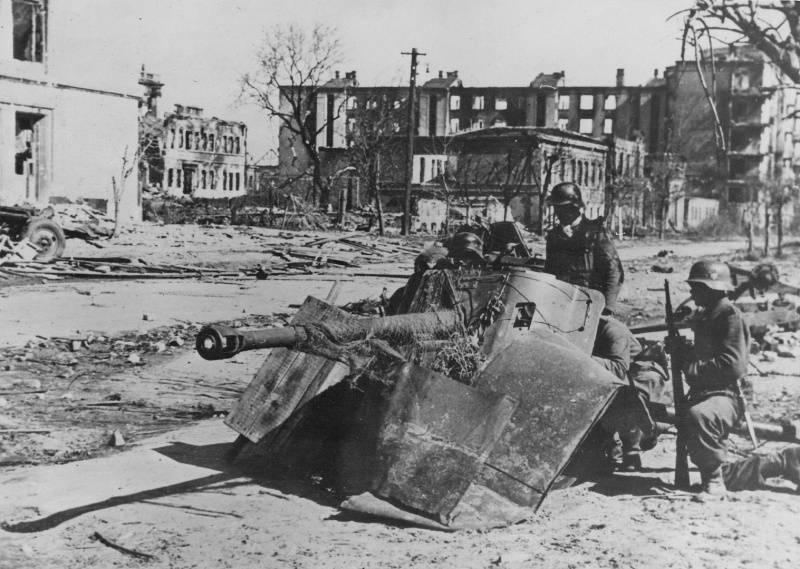
Calculation of the German 50-mm anti-tank gun PaK 38 at one of the crossroads of Stalingrad
On the night of September 18, the command post of Chuikov relocated to the Volga bank at the central crossing. To do this, I had to cross over to the east bank, rise upstream and return to the west bank. In addition to Rodimtsev's division, in the first days of the assault, the 62 and 95 rifle divisions, the 284 tank and 137 brigade of the marines were infused into the 92 army. The headquarters of the fully "expended" regiments were in turn relegated to the Volga, received a replenishment and returned to their positions.
After Chuikov’s army withstood the first terrible blow, it was greatly strengthened. According to the testimony of Marshal F.I. Golikova: “In September, new reserves of Stakes began to flow intensively. Brigade after brigade, division after division. In September, the 62 Army received seven fresh full-blooded divisions and five separate rifle brigades ... in September, the 62 Army was withdrawn to restore nine bloodless divisions ... The equipment of the army increased dramatically. ”
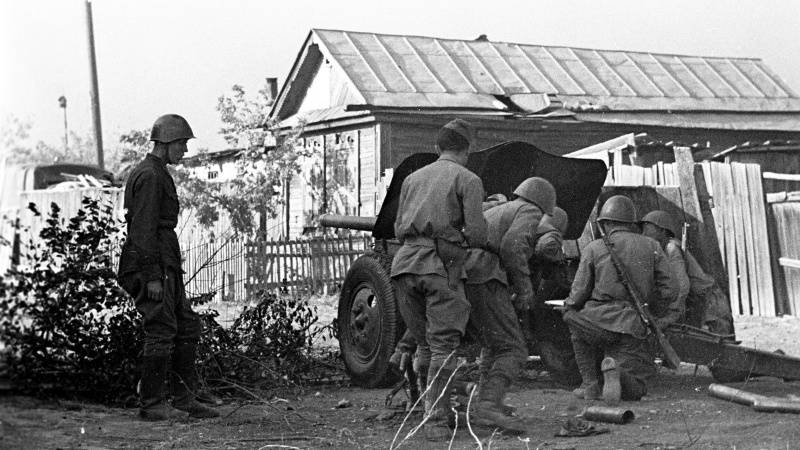
Red Army gunners at 76-mm divisional gun F-22-SPC on the street of Stalingrad
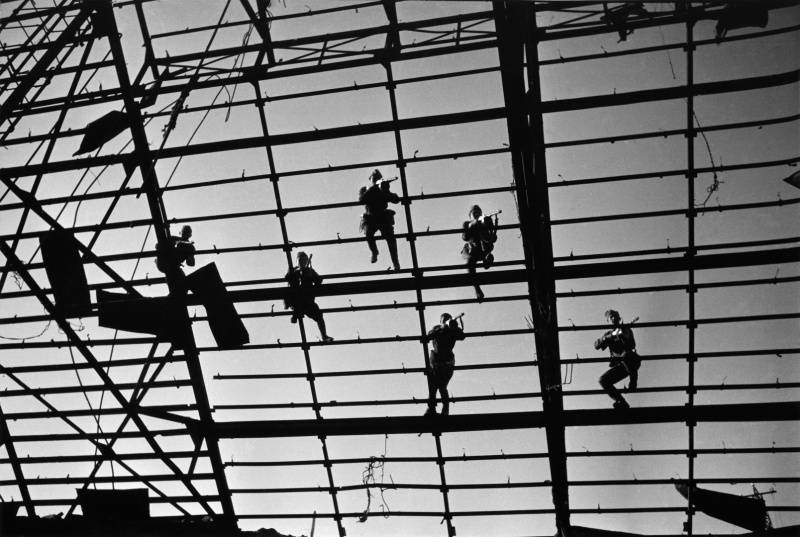
Soviet fighters firing from crates of the glass roof of one of the factory shops of Stalingrad
To be continued ...
Information